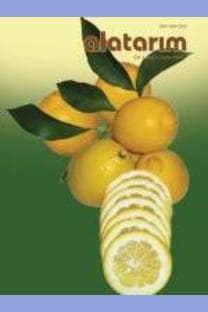Kuzugöbeği mantarı (Morchella spp.)'nın Türkiye'deki bölgesel yayılımı
Bu çalışmada 2007-2010 yılları arasında Türkiye’nin farklı bölgelerinden toplanarak moleküler yöntemlerle türleri belirlenmiş olan kuzugöbeği mantarının bölgesellik gösterip göstermediği belirlenmeye çalışılmıştır. Bu amaçla Türkiye’nin hemen hemen her yerinden toplanmış olan mantarların bölgesel analizi yapılmıştır. Deneme sonuçları kuzugöbeği mantarının bölgesellik göstermediğini, türlerinin neredeyse tamamına yakınının hemen hemen her bölgede bulunabileceğini göstermiştir. Günümüzde genetik kaynaklarla ilgili çalışmalar daha çok coğrafik dağılım ve endemizm üzerine yoğunlaşmıştır. Bu çalışma kuzugöbeği mantarının coğrafik dağılımı ile ilgili bilgilerin artırması nedeniyle bu konuda çalışanlara ışık tutacaktır.
Anahtar Kelimeler:
filogenetik, Morchella, Türkiye, endemik bitkiler
Regional distribution of morels (Morchella ssp.) in Turkey
In this study, it was aimed to determine if the morel mushroom exhibits any geographical distribution. For this purpose, the morel mushrooms collected from almost all regions of Turkey were analyzed for regional endemism. Outcomes of the study show that the morel mushroom does not show regional endemism and nearly all the varieties can be grown in all regions. Recent studies related with genetic resources are focused on geographical distribution and endemism. The results of this study will help the researchers in this area.
Keywords:
phylogenetics, Morchella, Turkey, endemic plants,
___
- Gençcelep, H., Uzun, Y., Tunçtürk, Y., Demirel, K., 2009. Determination of mineral contents of wild-grown edible mushrooms. Food Chemistry. 113:1033–1036.
- Iqbal, M., 1993. International trade in non-wood forest products: an overview. Working Paper Misc/93/11. Rome, Italy: Food and Agriculture Organization of the United Nations. Sec. 7.1 http://www.fao.org/documents/show_cdr.asp?url_file=/docrep /x5326e/x5326e00.htm.
- O’Donnell, K., Rooney, A.P., Mills, G.L., Kuo, M., Weber, N.S., Rehner, S.A., 2011. Phylogeny and historical biogeography of true morels (Morchella) reveals an early Cretaceous origin and high continental endemizm and provincialism in the Holarctic. Fungal Genetics and Biology, 48:252-265.
- Ower, R., 1982. Notes on the development of the morel ascocarp: Morchella esculenta. Mycologia. 74: 142–144.
- Ower, R.D., Mills, G.L., Malachowski, J.A., 1986. Cultivation of Morchella. U.S. Patent 4, 594, 809.
- Ower, R.D., Mills, G.L., Malachowski, J.A., 1988. Cultivation of Morchella. U.S. Patent 4, 757, 640.
- Ower, R.D., Mills, G.L., Malachowski, J.A., 1989. Cultivation of Morchella. U.S. Patent 4, 866, 878.
- Pilz, D., Mclain, R., Alexander, S., Villarreal-Ruiz, S.B., Wurtz, Parks, C.G., McFarlane, E., Baker, B., Molina, R., Smith, J.E., 2007. Ecology and Management of Morels Harvested From the Forests of Western North America. United States Department of Agriculture Forest Service Pacific Nortwest Research Station. General Technical Report, PNW-GTR-710, March 2007.
- Taşkın, H., Büyükalaca, S., Doğan, H.H., Rehner, S.A., O’Donnell, K., 2010. A Multigene Molecular Phylogenetic Assessment of True Morels (Morchella). Fungal Genetics and Biology, 47: 672-682.
- Taşkın, H., Büyükalaca, S., Hansen, K., O’Donnell, K., 2012. Multilocus phylogeneticanalysis of true morels (Morchella) reveals high levels of endemics in Turkey relative to other regions of Europe. Mycologia, 104(2): 446-461.
- ISSN: 1304-2653
- Başlangıç: 2015
- Yayıncı: Alata Bahçe Kültürleri Araştırma Enstitüsü
Sayıdaki Diğer Makaleler
Kuzugöbeği mantarı (Morchella spp.)'nın Türkiye'deki bölgesel yayılımı
Hatıra TAŞKIN, Saadet BÜYÜKLACA
Mehmet Naim DEMİRTAŞ, HALİL KIRNAK, İBRAHİM BOLAT, Oktay TANER, Sinan ÇOLAK, Sezai ŞAHİN, Ergün DOĞAN
Marathon brokoli çeşidinin verimi ve azot içeriği üzerine farklı azot dozlarının etkisi
Günsu ATAĞ ALTINDİŞLİ, Kadir KUŞVURAN, İsmail ŞEYHANLI, ŞEBNEM KUŞVURAN, H. Yıldız DAŞGAN
